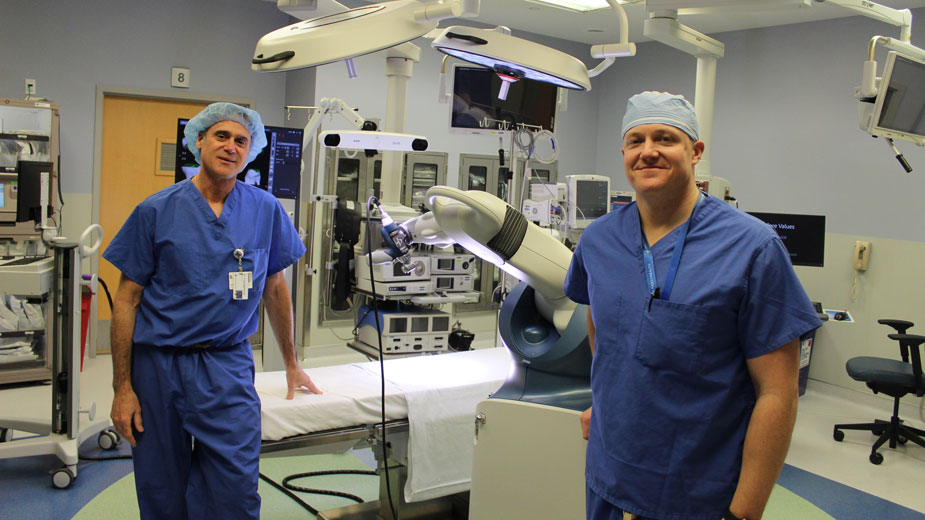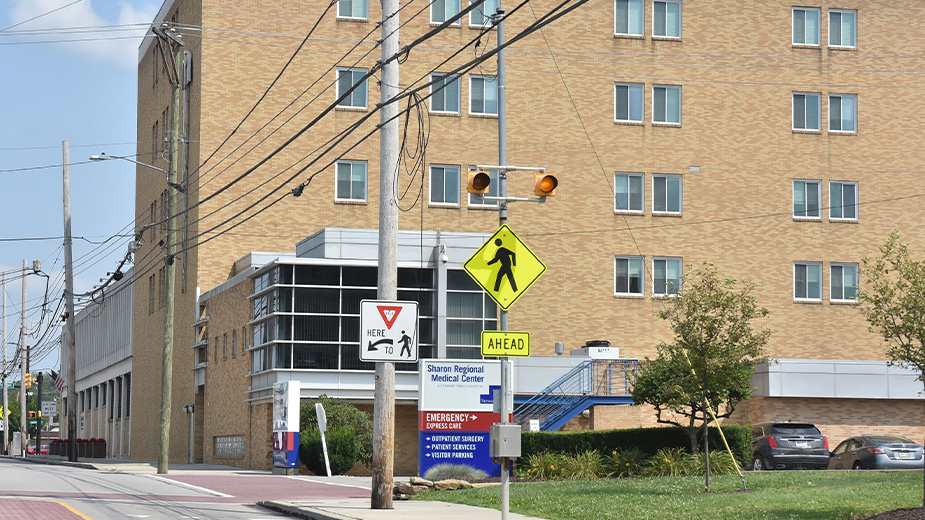Better Knees with Mercy’s Mako Robot
YOUNGSTOWN, Ohio – Inside an operating room at St. Elizabeth Boardman Hospital, Dr. Jeff Johnston holds a handle connected to the arm of a Mako surgical robot. Across from him is a screen with six images – it’s the same knee, just different views – criss-crossed with green lines, representing where he will make cuts during a knee replacement surgery.
For patients, the new robot, first used at the hospital Dec. 31, means more precise procedures. Traditionally, the surgeries are by-the-book with some variance based on a surgeon’s personal know-how for how the joint should be positioned.
“A lot of what you do for balancing a knee – making sure it feels good when it’s straight or bent and not too loose or too tight – we’re using our hands and own judgment,” explains Johnston, an orthopedic surgeon.
But after such surgeries, about 30% of patients are unhappy with the function of the joint, adds Dr. Thomas Boniface, because of things such as alignment, range of motion or even general comfort.
“Our best outcome is what we call a ‘forgotten knee’ where if we ask our patients about it, they say, ‘I don’t even think about it,’ ” he says. “Traditional total knee replacement wasn’t done with customization. There are preconceived notions of what angle the knee should be. One bone is cut at a consistent angle and the other is cut at a predetermined angle.”
This is where the Mako robot enters the picture. Before the surgery, patients have a computed tomography, or CT, scan of their knees, which generates a 3D model. The model is then plugged into the robot’s software, where doctors can determine where cuts will be made before the patient ever enters the operating room. And with that 3D model, those cuts can be customized to each patient, ensuring that his replacement is more comfortable.
“It’s like a crown – you don’t know that they’re there. When a dentist puts it in, it’s customized and aligned with the tops of your other teeth,” Boniface says. “It’s the same idea. If I put a knee two degrees off, the patient may feel that for the rest of their life. Our goal is to position this as precisely as possible.”
During the surgery itself, doctors operate the Mako via a robotic arm that has a trigger on the handle opposite a saw. Over the course of the operation, doctors can watch a screen with the 3D model overlaid with green lines representing the cuts, which can be altered in real time should it be necessary. If the saw strays from those lines, the machine stops spinning the blade.
“You can alter the way you install the implants and ultimately, that’s how the machine makes the cuts,” Johnstone says. “As we’re making cuts, we’re watching the screen. With all the nerves and blood vessels around the knee, you’re not at risk of hitting those.”
While the Mako robot is new at St. Elizabeth Boardman, it’s a technology that’s becoming more common in the industry. Last year alone, according to a representative from the manufacturer of the robot, Stryker, the robot was used in some 50,000 knee replacement surgeries around the world.
Last year, Zion Market Research estimated the global surgical robot market at $55 billion and forecast it to grow to $99 billion by 2024. While North America – specifically the United States – is projected to be the leader in spending, the Asia-Pacific and Latin American markets are expected to see the highest growth rates.
“Market growth is particularly projected in Brazil, China and India, among other emerging countries where the market penetration of surgical robots is anticipated to be the highest. High unmet medical needs and the increasing prevalence of chronic diseases have opened the doors for surgical-robots systems,” Zion Market Research said in its report.
In a 2018 survey, research firm Statista reported that its younger people who are more likely to opt for robot-assisted surgeries. In the 18 to 34 age range, 46% of respondents said they prefered aided procedures, while 39% preferred traditional methods. In the 35-to-44 age range, the numbers were more even, 45% opting for aided surgeries and 43% for traditional ones. But at older ages, the numbers flipped, with the 45-to-54, 55-to-70 and 70-plus segments all preferring traditional surgeries at about 60%, while robot-aided surgeries were preferred between 25% and 30% of the time.
“We really had to look at where the market’s going as far as technology. We knew that this was new technology that was going to expand throughout orthopedics,” says Kera Simmons, Mercy Health-Youngstown director of surgical business. “It’s really about looking at the clinical benefit and does that outweigh the cost? The investment is worth it because patients have better outcomes.”
In addition to the Mako robot, which costs about $1 million, at St. Elizabeth Boardman, the local Mercy system uses daVinci robots, priced at roughly $2 million apiece, at its three hospitals in the area. At St. Elizabeth Hospital near downtown Youngstown, a daVinci Xi is used for pancreatic, thoracic and general procedures, while St. Elizabeth Boardman has a Xi – a daVinci X will be added later this year as well – used for hysterectomies, hernia, colon, OB-GYN and general procedures. At St. Joseph Hospital in Warren, two daVinci Xi robots are used for OB-GYN, weight loss and hernia procedures.
Since Mercy Health-Youngstown installed its first daVinci robot in 2007, more than 4,500 procedures had been completed on the machines through the end of January, Simmons reports.
The machine has the surgeon sit at a control panel, controlling several robotic arms equipped with surgical tools that allow for more precise maneuvering during procedures. A camera allows the doctor to view exactly what the arms are doing as she controls it from nearby.
“With daVinci, the fact that you have smaller incisions – for patients that’s huge. It’s the cosmetic element of not having a large incision across your abdomen,” Simmons says. “From the patient’s perspective, that’s one of the big selling points.”
Pictured: The Mako robot is another tool in surgeons’ toolboxes, say Thomas Boniface and Jeff Johnston, surgeons with Mercy Health.
Copyright 2024 The Business Journal, Youngstown, Ohio.



